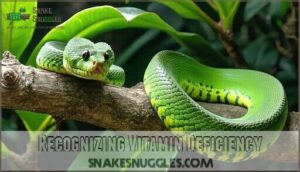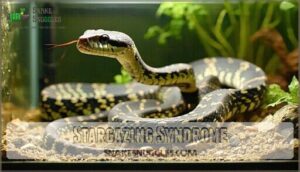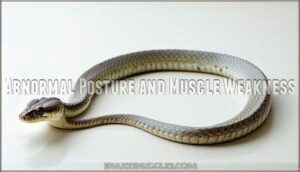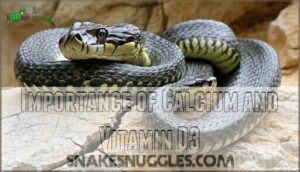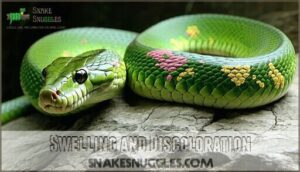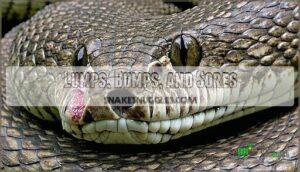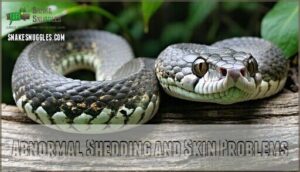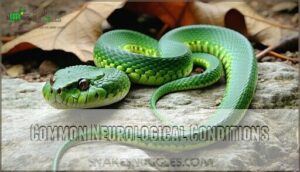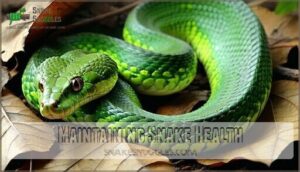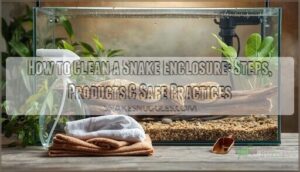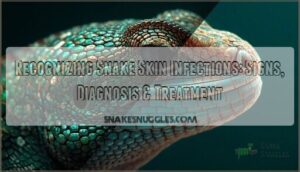This site is supported by our readers. We may earn a commission, at no cost to you, if you purchase through links.
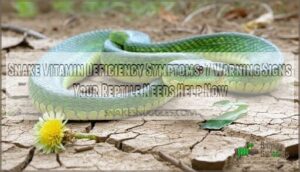
You might spot swelling, bumps, or unusual discoloration. Neurological issues like “stargazing” (when they awkwardly tilt their head up) or muscle tremors can also point to deficiencies, especially in calcium or vitamin D3.
Causes often involve inadequate UVB lighting or an unbalanced diet. It’s like giving a kid only candy—your snake needs variety too!
Fixing this starts with proper nutrition and supplements. Curious about the best diet tweaks? A good meal plan can work wonders.
Table Of Contents
- Key Takeaways
- Recognizing Vitamin Deficiency
- Signs of Neurological Problems
- Causes of Vitamin Deficiency
- Importance of Calcium and Vitamin D3
- Snake Vitamin Deficiency Symptoms
- Nutritional Needs of Snakes
- Preventing Vitamin Deficiency
- Treating Vitamin Deficiency
- Common Neurological Conditions
- Maintaining Snake Health
- Frequently Asked Questions (FAQs)
- What are the symptoms of vitamin A deficiency in reptiles?
- What are the symptoms of low vitamin deficiency?
- Should I give my snake vitamins?
- What are the symptoms of malnutrition in reptiles?
- How do you know if a reptile has vitamin A deficiency?
- What vitamin deficiency shows in your nails?
- What causes vitamin A deficiency in reptiles?
- Can vitamin A deficiency make a reptile sick?
- How do snakes get vitamin C deficiency?
- Can vitamin deficiency affect a snakes lifespan?
- Conclusion
Key Takeaways
- Watch for symptoms like poor shedding, lethargy, swollen eyes, or abnormal behavior (like stargazing) as early signs of vitamin deficiencies.
- Ensure your snake’s diet is balanced with proper calcium, vitamin D3, and variety in feeder prey to prevent deficiencies.
- UVB lighting is critical for vitamin D3 synthesis and calcium absorption—without it, bone health suffers.
- Regular vet check-ups and supplementation can address deficiencies quickly and avoid long-term health problems.
Recognizing Vitamin Deficiency
You’ll notice your snake isn’t feeling its best when vitamin deficiencies start showing up as lethargy, poor shedding, or those tell-tale twisted postures that scream "something’s wrong!"
Your quick action can make the difference between a speedy recovery and serious complications, so learning these warning signs is just as important as knowing which cricket bowl is your snake’s favorite.
Lethargy and Poor Shedding
Your snake’s sluggish movement and shedding troubles might be waving red flags about vitamin deficiency. Like a car running on empty, lethargy signals your reptile’s nutrient levels need attention.
Lethargy in your snake is like a blinking fuel light—your pet’s way of saying, "I need nutrients, fast!
- Dehydration often causes skin to stick during shedding
- Calcium deficiency makes shedding particularly difficult
- Environmental factors like low humidity worsen shedding issues
- Diet impact shows through reduced activity levels first
- Vitamin D3 shortages affect both energy and skin health
Don’t ignore these snake health problems—they’re your pet’s way of asking for help with nutrition or hydration levels.
Eye Problems and Appetite Loss
Beyond lethargy, your reptile may show concerning visual cues through their eyes and eating habits.
Watch for these snake vitamin deficiency symptoms:
- Cloudy or swollen eyes (classic signs of vitamin A deficiency)
- Discharge around eyelids that appears crusty or wet
- Sudden appetite decline or complete refusal of food
- Difficulty striking prey accurately (they might miss repeatedly)
- Visible weight loss along their sides
These eye problems and appetite loss aren’t just minor inconveniences—they’re warning flags of potential metabolic disease. When your snake shows these symptoms, it’s like they’re raising a distress signal that demands your immediate attention!
Bone Deformities and Muscle Weakness
While eye issues may catch your attention first, bone deformities and muscle weakness signal serious trouble in your snake. These symptoms typically indicate metabolic bone disease (MBD) from calcium deficiency.
| Symptom | What You’ll See | Action Needed |
|---|---|---|
| Jaw deformities | Soft, rubbery jaw | Calcium supplements |
| Spine issues | Kinks or bends | Vet visit ASAP |
| Muscle tremors | Shaking during movement | UVB lighting upgrade |
| Difficulty moving | Can’t lift body properly | Diet correction |
| Bone fractures | Unexplained injuries | Emergency vet care |
Don’t wait until your slithery friend can’t move normally—early intervention saves lives! It is crucial to address these issues promptly to prevent further complications, ensuring your snake receives the necessary care to recover from calcium deficiency and muscle weakness.
Signs of Neurological Problems
You’ll notice neurological problems in your snake when it shows head tilting, unusual body positions, tremors, or difficulty coordinating movements.
These symptoms often signal vitamin deficiencies that affect your reptile’s nervous system, much like how your car won’t run smoothly without the right fuel, which can be considered a form of nervous system issue.
Stargazing Syndrome
Have you noticed your pet snake looking at the ceiling? Stargazing syndrome—when your snake holds its head upward abnormally—is a serious neurological issue, not just curious behavior.
Stargazing can seem like innocent curiosity, but it’s a vital clue pointing to serious neurological issues in your snake.
This strange positioning can signal vitamin deficiency symptoms, particularly thiamine (B1), or indicate snake brain damage from infections like IBD or paramyxovirus.
Don’t wait for a diagnosis! Different causes require specific treatment options, and early intervention dramatically improves the prognosis factors. Your snake’s stargazing causes could be treatable if you act quickly.
Abnormal Posture and Muscle Weakness
Moving beyond stargazing, abnormal posture and muscle weakness signal serious nutritional issues in your snake. These neurological symptoms often indicate vitamin deficiencies affecting your pet’s health.
Watch for these warning signs:
- Twisted neck or abnormal spinal deformities
- Tremors or muscle atrophy in the body
- Inability to hold normal posture when resting
- Weakness diagnosis: difficulty moving normally
Don’t wait for these symptoms to worsen. Snake neurological issues require prompt posture correction through proper supplementation. A vet visit is your best next step to address neurological symptoms and ensure your pet’s health!
Seizures and Difficulty Moving
Watching your snake struggle with seizures can be terrifying – this isn’t normal behavior and requires immediate attention.
Seizures and movement difficulties often signal serious neurological problems stemming from vitamin deficiencies or infections.
| Symptom | Possible Cause | What You’ll See | Treatment Options | Urgency |
|---|---|---|---|---|
| Seizures | Calcium deficiency, infections | Shaking, twitching | Vitamin supplements, antibiotics | Immediate vet visit |
| Tremors | Neurological issues | Fine trembling | Supportive care | Within 24 hours |
| Paralysis | Thiamine deficiency | Inability to move | B-vitamin therapy | Emergency |
| Stargazing | Vitamin A deficiency | Head tilted upward | Vitamin A supplements | Urgent care |
| Circling | Multiple deficiencies | Moving in circles | Thorough treatment | Prompt attention |
Don’t wait – these snake neurological issues won’t resolve without proper treatment. Your reptile’s life depends on quick action!
Causes of Vitamin Deficiency
Your snake’s health depends heavily on its diet and environment, but even small mistakes can lead to vitamin deficiencies.
Missing UVB lighting or feeding improperly prepared prey mightn’t seem like a big deal, but they can cause serious issues over time.
Poor Diet and Lack of UVB Lighting
A poor diet and lack of UVB lighting can wreak havoc on your snake’s health. Without proper care, snake vitamin deficiency symptoms can sneak up fast.
Here’s what to watch for:
- Dietary Imbalance: Feeding the wrong prey leads to inadequate calcium and vitamin D3 intake. Prey gutloading helps!
- UVB Importance: UVB lighting is essential for calcium absorption. Without it, bones weaken.
- Natural Sunlight: No UVB? Try safe outdoor sunlight exposure.
Avoid supplementation risks by balancing diet and lighting. Metabolic bone disease can be prevented with proper UVB exposure. A little effort keeps your snake thriving, not just surviving!
Inadequate Calcium and Vitamin D3
In the context of snake health, calcium and vitamin D3 are the dream team.
Calcium keeps bones strong and supports muscle function, while vitamin D3 guarantees proper calcium absorption—without it, most calcium just goes to waste.
A lack of these nutrients can lead to snake metabolic bone disease, causing weak bones and mobility issues.
Though snakes don’t rely heavily on UVB lighting for vitamin D3 synthesis like other reptiles, UVB importance shouldn’t be ignored, especially for species needing extra help with bone metabolism.
Whole prey diets usually provide enough calcium, but young snakes fed pinkies (low in minerals) may need supplements.
Always check supplement ratios—too much or too little can harm your snake’s calcium absorption and overall health.
Thiamine Deficiency and Incorrectly Prepared Fish
Thiamine deficiency can sneak up on fish-eating snakes if their meals aren’t properly prepared. Thiamine, a B-vitamin, is essential for neurological function, and a lack of it can cause serious snake vitamin deficiency symptoms.
Feeding improperly prepared fish is like giving your snake a recipe for trouble. Here’s how to avoid it:
- Avoid raw fish high in thiaminase, an enzyme that destroys thiamine.
- Cook fish lightly to deactivate thiaminase.
- Rotate dietary sources to meet snake nutritional needs.
- Offer thiamine supplements if needed.
- Consult a vet for treatment options if symptoms arise.
Importance of Calcium and Vitamin D3
Your snake’s bones and muscles rely on calcium to stay strong, but without vitamin D3, it can’t absorb calcium properly.
Think of it like trying to fill a bucket with holes—no matter how much you pour in, it won’t do any good, which relies on the concept of calcium absorption.
Role of Calcium in Snake Health
Calcium is like the foundation of a sturdy house—it keeps your snake’s body strong and functional.
Without it, your pet risks metabolic bone disease (MBD) and other health issues. Calcium supports bone development, muscle function, and even the shedding process.
Watch for signs of calcium deficiency in snakes, like a soft jaw, tremors, or a kinked spine.
- Builds strong bones and prevents MBD
- Aids in muscle function and movement
- Guarantees a smooth shedding process
- Keeps nerves firing properly
- Regulates blood clotting
Use snake calcium powder with proper supplement ratios to keep them thriving!
Importance of Vitamin D3 in Calcium Absorption
Think of vitamin D3 as the key that activates calcium’s potential in your snake’s body.
Without it, calcium absorption plummets, risking metabolic bone disease (MBD). Snakes rely on UVB lighting to synthesize D3 naturally, but supplements can help too.
A vitamin D deficiency snake might show signs like weak bones or poor shedding. Balance is vital—too little D3, and calcium bioavailability drops; too much, and toxicity looms.
| Source | D3 Mechanisms | Calcium Bioavailability |
|---|---|---|
| UVB Lighting | Natural Synthesis | High |
| Vitamin D Supplements | Synthetic Support | Moderate |
| Poor Diet | Limited Intake | Low |
| No UVB | None | None |
| Balanced Approach | Ideal Levels | Excellent |
Keep UVB dependence in mind to prevent calcium deficiency snake issues!
Choosing The Right Calcium Supplement
Choosing the right calcium supplement can feel like a puzzle, but it’s simpler than it seems.
Here’s a quick guide:
- Calcium Sources: Opt for powdered forms like snake calcium powder for better absorption.
- D3 Inclusion: Verify that it contains vitamin D3 to prevent metabolic bone disease.
- Powder vs Liquid: Stick with powders; liquids can be tricky to dose.
- Phosphorus Ratio: Look for phosphorus-free options.
- Supplement Schedule: Follow dosing instructions to avoid calcium deficiency in your snake.
Consider powder product availability when choosing a supplement.
Your snake’s health depends on it!
Snake Vitamin Deficiency Symptoms
Your snake’s health can take a hit if it’s missing key vitamins, and the signs aren’t always obvious.
From sluggish behavior to strange skin issues, these symptoms are your reptile’s way of waving a red flag.
Swelling and Discoloration
If your snake shows subcutaneous edema (fluid accumulation under the skin) or scale discoloration, it’s a flashing warning sign.
These symptoms, along with skin fragility or serosanguinous tearing (bloody fluid leaks), often point to snake vitamin deficiency symptoms like hypovitaminosis A.
Watch for cloudy or swollen eyes or snake skin discoloration, as these may signal circulation issues or infections.
Don’t delay—get a vet involved. Quick action can prevent serious complications and keep your reptile healthy and vibrant.
Lumps, Bumps, and Sores
Bumps, lumps, or sores on your snake’s skin can signal trouble lurking beneath those scales.
While some might just be harmless scars from a tough shed, others could hint at deeper issues like abscesses, scale infections, or even tumor concerns.
Trauma wounds or snake skin tears might lead to cysts or snake subcutaneous edema if left untreated.
Skin infections are another possibility, especially if the enclosure isn’t spotless, which can lead to serious snake skin issues.
Spot something unusual? Don’t brush it off—your vet can help with abscess identification, cyst removal, or other treatments to keep your snake’s skin problems from escalating.
Abnormal Shedding and Skin Problems
Does your snake struggle with poor shedding or fragile skin? Abnormal shedding and snake skin issues can indicate serious health concerns like vitamin deficiencies or improper care.
Look out for these signs:
- Shedding difficulties, such as retained skin patches.
- Tearing skin, which appears thin or weak.
- Subcutaneous edema, or fluid swelling beneath the scales.
- Discolored or damaged scales, often due to infections like scale rot.
Left untreated, these problems can worsen, leading to infections or impaired mobility. Proper humidity, a balanced diet, and UVB lighting are key to preventing snake skin problems.
Maintaining proper humidity is essential, as low humidity causes dysecdysis. Help your scaly friend shed like a champ!
Nutritional Needs of Snakes
Your snake’s health starts with proper nutrition, and it’s not as simple as tossing in a mouse and calling it a day.
They need the right balance of vitamins, minerals, and UVB lighting to thrive, or you could end up with a very unhappy reptile.
High Temperatures for Digestion
Your snake’s digestion runs on heat—it’s like their internal engine needs a warm spark to work efficiently.
Suboptimal temperatures in their enclosure can slow digestion, causing regurgitation or other snake health issues.
To boost digestion efficiency, maintain ideal temperatures with proper heating methods.
- Create a temperature gradient so your snake can move between warm and cool spots.
- Adjust temperatures based on species variation for their unique needs.
- Monitor enclosure heat regularly to avoid fluctuations.
- Use thermostats or heat mats for consistent warmth.
Warm belly, happy snake!
Calcium and Vitamin D3 Requirements
For strong bones and muscles, your snake needs calcium and vitamin D3 working together.
Without them, metabolic bone disease (MBD) can cause bone deformities and muscle weakness.
Calcium absorption depends on D3 synthesis, so dust prey with calcium powder and make certain of proper UVB exposure.
Keep supplement ratios balanced—too much can harm! Whole prey diets usually provide enough, but double-check to prevent issues.
Think of it as a wellness plan for your reptile!
Importance of Vitamin a and UVB Lighting
Your snake’s health depends on UVB lighting and vitamin A benefits working hand in hand.
UVB synthesis helps produce vitamin D3, essential for calcium absorption and strong bones.
On the flip side, vitamin A prevents snake eye problems, poor shedding, and skin issues.
Use a proper lighting spectrum (290-320 nm) to mimic sunlight, but watch out for supplementation risks—too much vitamin A can harm.
Aiding in this process, UVB light prevents MBD.
Deficiency prevention starts with balanced care, ensuring your reptile thrives, not just survives.
Preventing Vitamin Deficiency
You can keep your snake healthy by focusing on its diet, hygiene, and regular check-ups.
A little effort now saves you from big headaches later—no one wants a grumpy, vitamin-starved snake!
Providing a Balanced Diet
A balanced diet keeps your snake thriving and free from snake vitamin deficiency symptoms.
Start with Prey Variety—alternate between mice, rats, and other suitable options to meet reptile nutrition needs. Pay attention to Rodent Gutload; well-fed prey means better nutrients for your snake.
Size matters! Follow snake feeding guidelines by matching prey to your pet’s size and age.
Don’t skip Supplementation Needs—dust prey with calcium and vitamins to prevent a snake diet deficiency. Stick to proper feeding frequency, and always guarantee hydration importance by providing fresh water.
A happy, healthy snake begins with a thoughtful, balanced diet! Guaranteeing proper calcium intake with reptile calcium supplements is also very important.
Ensuring Proper Hygiene and Sanitation
A clean snake enclosure is your first defense against snake vitamin deficiency and other health concerns.
Regular deep cleaning with safe disinfectant choices keeps harmful bacteria at bay. Keep water sanitation in check by changing it daily, ensuring freshness.
Don’t let waste pile up—prompt waste removal is essential. Follow quarantine protocols for new snakes to prevent cross-contamination.
A spotless home means a healthier, happier snake, and fewer worries for you, thanks to regular deep cleaning and safe disinfectant choices.
Regular Check-Ups With a Veterinarian
Regular vet check-ups are like a safety net for your snake’s health, catching issues before they spiral. Snakes are masters at hiding problems, so early detection is key to tackling snake vitamin deficiency symptoms.
Vets use diagnostic tools to spot reptile vitamin deficiencies and offer expert advice on preventative care. They’ll recommend treatment options like supplements or habitat adjustments to keep your snake thriving. A vet can also help confirm you’re maintaining proper temperature within the enclosure.
- Thorough physical exams to identify subtle signs of illness
- Tailored dietary advice to address reptile vitamin deficiency
- Habitat improvement tips for long-term health
Don’t wait for trouble—regular veterinary care keeps your snake slithering happily!
Treating Vitamin Deficiency
Treating vitamin deficiency in your snake means tackling the root causes and giving the right supplements.
It’s like being a detective and a chef—figuring out what’s missing and serving up the perfect fix!
Addressing Underlying Causes
If your snake is showing vitamin deficiency symptoms, it’s time to dig into the "why."
Think of yourself as a detective solving a health mystery.
Start by examining their dietary imbalance—are they eating a variety of properly fed prey?
A poor diet often leads to malnourished snakes and snake illnesses.
Next, check their UVB provision.
Without proper lighting, they can’t synthesize vitamin D3, essential for calcium absorption.
Don’t overlook hygiene practices and sanitation issues in their enclosure.
Dirty habitats can stress snakes and worsen health problems.
Stress itself, from overcrowding or improper handling, can also trigger deficiencies.
Finally, schedule regular checkups with a vet to rule out parasites or underlying conditions.
By addressing these root causes, you’re not just treating symptoms—you’re preventing them from returning.
Think of it as giving your snake the VIP treatment they deserve!
Administering Supplements and Medications
When tackling vitamin deficiencies, snake supplements are your go-to tools for better health. Administering them isn’t tricky, but precision matters. Use a reptile multivitamin supplement or dust prey with calcium powder to boost their diet. If UVB lighting’s lacking, add vitamin D3 supplements.
For stubborn eaters, oral medications like liquid vitamins work wonders. Consider reptile vitamin options for ideal health. Follow your vet’s Supplement Dosage instructions carefully—no shortcuts here!
- Injection Techniques: Vet-only for safety.
- Oral Medications: Easy for picky eaters.
- Vitamin Interactions: Avoid overdosing.
- Monitoring Treatment: Watch for improvements.
Start slow and steady—your snake will thank you!
Monitoring Progress and Adjusting Treatment
Your snake’s recovery journey is like a slow but steady slither—patience wins.
Track symptoms carefully to spot changes. Adjust supplement timing and dosage as needed, based on progress or veterinary consults. Dietary changes might also speed up snake health improvement. Use blood work and shedding cycles as benchmarks.
Focus Area Action Goal
Every shed’s a step closer to health!
Common Neurological Conditions
Your snake’s nervous system can take a hit when key vitamins are missing, leading to strange behaviors or movement issues.
Recognizing these neurological conditions early can make all the difference in keeping your reptile healthy and happy.
Inclusion Body Disease (IBD)
In regards to snake health issues, Inclusion Body Disease (IBD) is a heavyweight among common snake diseases.
This viral condition messes with your snake’s nervous system, causing snake illness symptoms like stargazing or odd, knot-like movements.
Here’s what to watch for:
- Abnormal posture or difficulty moving.
- Frequent regurgitation after meals.
- Erratic shedding patterns.
- Lethargy or lack of appetite.
- Neurological signs like tremors or twisting.
IBD transmission occurs through direct contact, making early IBD diagnosis essential.
Though there’s no cure, ongoing IBD research offers hope for better IBD management.
Pinhead Syndrome and Head Wobble Syndrome
Spotting pinhead syndrome or head wobble syndrome in your snake’s behavior? These neurological problems can signal trouble.
Pinhead syndrome appears as a small head paired with a big body, often due to genetic issues (Pinhead Causes). Head wobble syndrome, linked to spider morph ball pythons (Wobble Genetics), creates shaky movements resembling subtle dancing.
Both conditions affect coordination, leading to abnormal posture or seizures (Neurological Impact).
Deformity Diagnosis requires a vet’s expertise, but with treatment options like proper care and supplements, you can improve their quality of life.
Monitor symptoms like stargazing syndrome or unsteady motions to protect their health.
Dysecdysis and Septicemia
Poor shedding, or dysecdysis, is like your snake wearing a too-tight sweater—it’s uncomfortable and risky.
Look for stuck skin or incomplete sheds that could lead to skin infections. Septicemia causes serious trouble, spreading bacteria through the bloodstream. Watch for lethargy, discolored scales, or loss of appetite. Fast action matters!
- Address shedding complications with proper humidity and soaks.
- Learn septicemia causes and infection risks to act quickly.
- Prevention tactics: clean enclosures, balanced diets, regular vet visits.
Maintaining Snake Health
Keeping your snake healthy isn’t just about feeding it mice; it’s about understanding its unique needs.
With proper care, good nutrition, and a watchful eye, you can help your reptile thrive.
Providing Proper Care and Nutrition
Keeping your snake healthy isn’t rocket science—it’s all about the right care.
A clean, cozy enclosure with perfect temperatures guarantees comfort.
Offer a Balanced Snake Diet by mixing prey types and practicing Prey Gut-Loading—feeding prey nutritious diets before feeding them to your snake.
Use Supplementation Strategies like dusting prey with calcium and vitamins to avoid snake vitamin deficiency symptoms.
Always maintain Hydration Importance with fresh, clean water, and add a little Environmental Enrichment like climbing branches.
Stick to a consistent schedule to meet your snake’s dietary needs and optimize snake health.
Recognizing Signs of Illness
Your snake can’t talk, but its body language says a lot.
Early detection of illness starts by spotting subtle clues. Snake lethargy might turn your lively buddy into a still statue.
Shedding issues could leave its scales looking patchy or dull. Appetite changes, like outright skipping meals, might point to snake anorexia or other health concerns.
Watch for cloudy eyes, muscle weakness, or physical abnormalities like bone deformities—common snake vitamin deficiency symptoms.
These signs aren’t minor! They’re your snake’s way of waving a red flag. Catching these behavioral changes early can keep your scaly pal slithering happily and healthily.
Consulting a Veterinarian for Regular Check-Ups
Regular veterinary check-ups are like a wellness plan for your snake, catching issues before they spiral.
Think of it as preventative care with a purpose—ensuring early detection of problems like snake vitamin deficiency symptoms or other reptile health concerns.
Your vet will handle health monitoring, from parasite tests to evaluating your snake’s enclosure.
Plus, they’ll dish out expert advice on diet and habitat tweaks.
Regular visits boost snake health by addressing nutrition, like calcium absorption or lighting needs.
Schedule these reptile veterinary consultations—they’re your ace for avoiding bigger issues down the road!
Frequently Asked Questions (FAQs)
What are the symptoms of vitamin A deficiency in reptiles?
Think of your reptile’s health as a puzzle—missing vitamin A can cause anorexia, stunted growth, swelling, and inflammation.
Watch for these clues to guarantee they stay vibrant, active, and pieced together flawlessly.
What are the symptoms of low vitamin deficiency?
Low vitamin levels can make you feel sluggish, mess with your appetite, and even weaken your muscles.
Watch for signs like cloudy eyes, swelling, or odd movements—it’s your body waving a giant red flag!
Should I give my snake vitamins?
Approximately 60% of captive reptiles face vitamin deficiencies.
Your snake mightn’t need vitamins if its diet and environment are spot on.
But, if signs of deficiency appear, talk to a vet before supplementing.
What are the symptoms of malnutrition in reptiles?
Your reptile’s malnutrition symptoms include lethargy, poor shedding, swollen eyes, appetite loss, weak muscles, tremors, and fragile skin.
If you notice any of these issues, it’s a sign to check their diet and care setup.
How do you know if a reptile has vitamin A deficiency?
Spotting vitamin A deficiency feels like decoding a secret message.
If you notice swelling, stunted growth, inflamed skin, or your reptile struggling to eat, it’s time for a vet visit and some diet adjustments.
What vitamin deficiency shows in your nails?
Your nails can reveal vitamin deficiencies.
Brittle, splitting, or slow-growing nails might point to low biotin or iron levels.
White spots could hint at zinc deficiency.
Take care of your diet—your nails will thank you!
What causes vitamin A deficiency in reptiles?
A poor diet lacking vitamin-rich vegetables, insufficient UVB lighting, and imbalanced calcium-to-phosphorus ratios often cause vitamin A deficiency in reptiles.
Without these essentials, their bodies struggle to absorb and utilize this essential nutrient properly.
Can vitamin A deficiency make a reptile sick?
Imagine your pet moving sluggishly, eyes swollen, and refusing food.
Vitamin A deficiency can weaken its immune system, cause breathing issues, and lead to infections.
A proper diet and supplements work wonders—don’t wait!
How do snakes get vitamin C deficiency?
Snakes develop vitamin C deficiency if their feeder rodents lack proper nutrition or have been starved.
Kidney or intestinal diseases can also impair vitamin C production, as snakes naturally produce this vitamin in these organs.
Can vitamin deficiency affect a snakes lifespan?
Vitamin deficiency drastically dampens a snake’s lifespan, disrupting digestion, movement, and shedding.
Without proper nutrients or UVB exposure, health spirals quickly.
Balanced diets and supplements guarantee your slithery companion lives long and sheds happily—no scales wasted, ensuring a long and happy life is not the focus but rather the outcome of proper care.
Conclusion
An ounce of prevention is worth a pound of cure, especially for your snake’s health.
Spotting snake vitamin deficiency symptoms early, like poor shedding or stargazing, can make all the difference.
Address issues with a proper diet, UVB lighting, and the right supplements, especially calcium and vitamin D3.
Stay alert to subtle signs, and don’t hesitate to consult a reptile vet.
A little effort goes a long way in keeping your scaly friend thriving and healthy!
- https://www.petsmart.com/learning-center/reptile-care/bearded-dragon-care-guide/Ahtml
- http://www.reptilesmagazine.com/Reptile-Health/Ask-A-Vet/Snake-Skin-Peel-And-Vitamin-C-Deficiency/
- https://en.wikivet.net/Hypovitaminosis_C_-_Reptiles
- https://reptile-savvy.webs.com/nutritionanddisease.htm
- http://www.arav.com/

